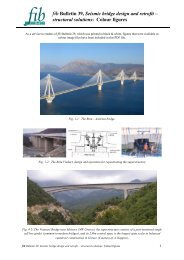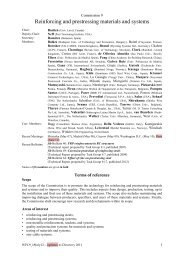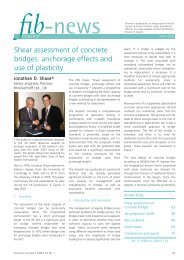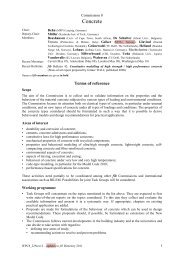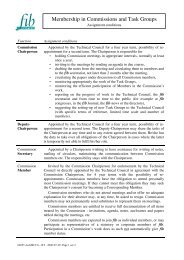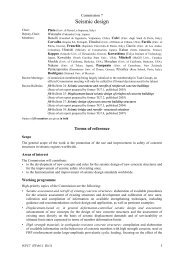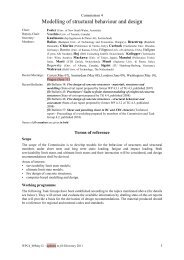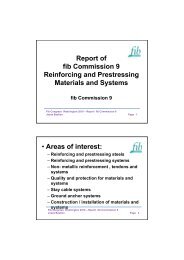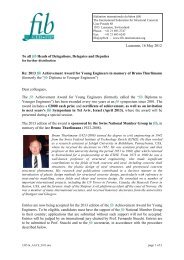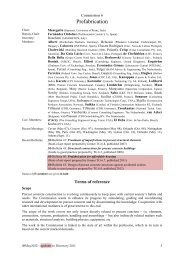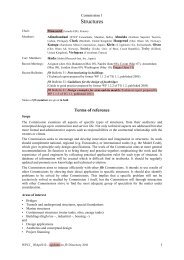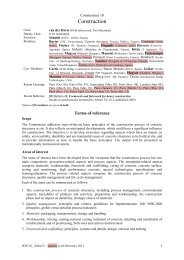Prefabrication - The International Federation for Structural Concrete
Prefabrication - The International Federation for Structural Concrete
Prefabrication - The International Federation for Structural Concrete
You also want an ePaper? Increase the reach of your titles
YUMPU automatically turns print PDFs into web optimized ePapers that Google loves.
Commission 6<br />
<strong>Prefabrication</strong><br />
Chair: Menegotto (Sapienza, University of Rome, Italy)<br />
Deputy-Chair: Fernández Ordoñez (Prefabricados Castelo S.A., Spain)<br />
Secretary: Ronchetti (ASSOBETON, Italy)<br />
Members: Albert (Hochschule Bochum, Germany), Beluzsár (Pfleiderer Labatlani Vasbetonipari Rt.,<br />
Hungary), Calavera (INTEMAC, Spain), Chastre Rodrigues (Univ. Nova de Lisboa, Portugal),<br />
Cholewicki (Building Research Institute (ITB), Poland), Crisp (Crisp Consultants Pty. Ltd.,<br />
Australia), Da Guia Lúcio (Univ. Nova de Lisboa, Portugal), de Chefdebien (LB7, France),<br />
Della Bella (Grupo Centro Nord SpA, Italy), Derkowski (Cracow Technical Univ., Poland),<br />
Doniak (ABCIC, Brazil), Elliott (Consulting Engineer, United Kingdom), Engström<br />
(Chalmers Univ. of Technology, Sweden), Fernández Gómez (Laboratorio Central INTEMAC,<br />
Spain), Ferrari (Consulting Eng., Italy), Falger (BAM Advies & Engineering <strong>The</strong> Netherlands),<br />
Ferreira (Federal Univ. Sao Carlos, Brazil), Gasperi (Consulting Eng., Italy), Hughes (Hollow<br />
Core <strong>Concrete</strong> Pty. Ltd., Australia), Jones (CDC Ltd., UK), Kanappan (Larsen & Toubro Ltd.,<br />
India), Karutz (CPI, Germany), Korander (Consolis Technology Oy Ab, Finland), Laliberté<br />
(BPDL Precast <strong>Concrete</strong> <strong>International</strong>, Canada), Lindström (Strängbetong, Sweden), Maas<br />
(Echo, Belgium), Mary (Rector Lesage, France), Murayama (Spancrete Corporation, Japan),<br />
Newby (Holmes Consulting Group, New Zealand), Saha (L&T, ECC Division, India), Sasek<br />
(Mott MacDonald Praha, Czech Republic), Scalliet (CERIB, France), Sennour (Consulting<br />
Engineers Group, USA), Seshappa (Composite Technologies Corp., USA), Skjelle (Construction<br />
Products Association, Norway), Suikka (Confed. of Finnish Construction Industries RT, Finland),<br />
Tillmann (FDB, Germany), Tillmann (FDB, Germany), Tsoukantas (National Techn. Univ.<br />
of Athens, Greece), Vambersky (Corsmit Consulting Engineers, <strong>The</strong> Netherlands), van Acker<br />
(Belgium), van Paassen (VBI Ontwikkeling BV, <strong>The</strong> Netherlands)<br />
Corr. Members: d’Arcy (<strong>The</strong> Consulting Engineers Group, Texas, USA), El Debs (Univ. de Sao Paulo, Brazil),<br />
Krohn (PCI, USA)<br />
Recent Meetings: Cavtat (May 07), Cracow (Oct. 07), Amsterdam (May 08), Orlando (Oct. 08), Nottingham<br />
(May 09), Paris (Oct. 09), Washington (May 10), Lisbon (Oct. 10), Helsinki (May 11),<br />
Athens (Sept. 11), Rio de Janeiro (March 12)<br />
Recent Bulletins: fib Bulletin 41: Treatment of imperfections in precast structural elements<br />
(State-of-art report prepared by <strong>for</strong>mer TG 6.8, published 2007)<br />
Names of fib members are given in bold<br />
Scope<br />
fib Bulletin 43: <strong>Structural</strong> connections <strong>for</strong> precast concrete buildings<br />
(Guide to good practice prepared by TG 6.2, published 2008)<br />
fib Bulletin 60: <strong>Prefabrication</strong> <strong>for</strong> af<strong>for</strong>dable housing<br />
(State-of-art report prepared by <strong>for</strong>mer TG 6.7, published 2011)<br />
fib Bulletin 63: Design of precast concrete structures against accidental actions<br />
(Guide to good practice prepared by TG 6.9, published 2012)<br />
Terms of reference<br />
Precast concrete construction is evolving continuously to keep pace with current society’s habits and<br />
needs. <strong>The</strong> Commission wants to enhance its progress by stimulating, guiding and coordinating<br />
research and development on precast concrete and by disseminating the knowledge. Cooperation with<br />
other international institutes is of great interest to this end.<br />
<strong>The</strong> scope of the work covers not only issues directly related to precast concrete – i.e. elements,<br />
connections, systems, production, handling and assemblage – but also indirectly related matters such<br />
as materials, structural analysis, building physics, equipment, etc.<br />
<strong>The</strong> work in the Commission is linked to the state of art within the profession, which in its turn is<br />
based on the current marked demands.<br />
22May2012 – updates to Directory 2011 1
Areas of interest<br />
<strong>Structural</strong> efficiency<br />
Structures that occupy less volume inside the building and that can easily accommodate equipment are<br />
increasingly requested. <strong>Structural</strong> efficiency helps also to save weight, which results in subsequent<br />
savings in the foundations, and, particularly <strong>for</strong> seismic constructions, also in the whole resisting<br />
system. This applies also to structures other than buildings, e.g. standard bridges, flyovers, etc.<br />
Flexibility in use<br />
Buildings are frequently required to adapt to variable needs of users, achieved by creating large free<br />
internal spaces, without restrictions by possible subdivisions. Also, the typology of the elements must<br />
be open to variations.<br />
Adaptability<br />
Less demolition of entire buildings and more adaptation of older buildings to new requirements will be<br />
required. <strong>The</strong> design concept should facilitate such renovations and modifications, e.g. changing<br />
façades without demolition of the rest of the structure.<br />
Best use of materials<br />
Each construction material possesses specific properties and optimal applications. <strong>The</strong> trend is to use a<br />
combination of different materials suited <strong>for</strong> the particular function among the structural and the<br />
architectural components.<br />
Speed of construction<br />
Construction sites disturb the surrounding area by creating noise and dust and disturbing traffic,<br />
there<strong>for</strong>e their duration must be as short as possible. <strong>The</strong> economic advantage of reduced construction<br />
time is obvious.<br />
Quality consciousness<br />
<strong>The</strong> structural robustness and the quality of materials and execution and also user-friendliness,<br />
com<strong>for</strong>t, aesthetics, duration are considered, as well as the quality within production, starting from the<br />
work conditions, continuing with the working effectiveness, and up to the output results.<br />
Sustainability<br />
Preserving the environment is of paramount importance on global scale. In addition to encouraging the<br />
reuse of structures <strong>for</strong> adaptability, further issues include recycling elements and/or materials,<br />
reduction of materials emissions, use of raw materials, waste dumping, noise and dust, etc.<br />
Working programme<br />
Basic research<br />
• per<strong>for</strong>mance of precast elements, connections, assemblies, by means of experimental testing and<br />
analytical modeling;<br />
• overall structural behaviour, durability, robustness;<br />
• resistance to fire, fatigue and accidental actions, repair and retrofit;<br />
• innovative materials.<br />
Application of new materials (in co-operation with Commissions 8 and 9)<br />
• high-per<strong>for</strong>mance concrete;<br />
• high-strength lightweight concrete;<br />
• self-compacting concrete;<br />
• fiber-rein<strong>for</strong>ced concrete;<br />
• non-metallic rein<strong>for</strong>cements.<br />
Production technologies and products<br />
• production technologies and optimization of processes;<br />
• hollow-core floors;<br />
• bridge components;<br />
• railway track systems;<br />
• af<strong>for</strong>dable cost construction;<br />
• cladding panels.<br />
22May2012 – updates to Directory 2011 2
Normative and pre-normative work<br />
• pre- and post-normative studies aimed at supporting the development of codes and standards;<br />
• interaction with fib commissions and participation in the elaboration of the 2010 Model Code;<br />
• elaboration of recommendations and guides to good practice on production, handling, erection and<br />
maintenance of precast elements and structures.<br />
Dissemination of knowledge<br />
• publication of technical reports, state-of-art reports, recommendations, handbooks, etc.;<br />
• interaction with other scientific and technical organizations;<br />
• organization of short courses;<br />
• seminars and workshops <strong>for</strong> professionals;<br />
• dedicated sessions in congresses and symposia.<br />
Task Group<br />
TG 6.1 Prestressed hollow-core floors<br />
Convener: Maas (Echo, Belgium)<br />
Members: Cholewicki (Building Research Institute (ITB), Poland), Crisp (Crisp Consultants Pty. Ltd.,<br />
Australia Della Bella (Gruppo Centro Nord SpA, Italy), Derkowski (Cracow Technical Univ.,<br />
Poland), Elliott (Consulting Engineer, United Kingdom), Ferreira (Federal Univ. Sao Carlos,<br />
Brazil), Korander (Consolis Technology Oy Ab, Finland), Lindström (Strängbetong,<br />
Sweden), Mary (Rector Lesage, France), Scalliet (CERIB, France), Suikka (Confed. of<br />
Finnish Construction Industries RT, Finland), Tsoukantas (National Techn. Univ. of Athens,<br />
Greece), van Acker (Belgium), van Paassen (VBI Ontwikkeling BV, <strong>The</strong> Netherlands)<br />
Recent Meetings: as Commission<br />
Names of fib members are given in bold<br />
Terms of reference<br />
In 1988 the FIP Commission on <strong>Prefabrication</strong> published design recommendations <strong>for</strong> 'Precast<br />
prestressed hollow core floors', in which the following items were treated: transfer of stresses at the<br />
support zone, shear capacity, transverse load distribution, diaphragm action, fire safety and<br />
connections. In the meantime the Task Group has finalised complementary guidelines <strong>for</strong> the design<br />
which were published in 1998 as FIP/fib guide to good practice Composite floor structures and in<br />
2000 as fib Bulletin 6 (guide to good practice) Special design considerations <strong>for</strong> precast prestressed<br />
hollow core floors. <strong>The</strong> document gives the latest state of knowledge concerning transfer of<br />
prestressing, restrained composite supports, non-rigid supports, floor diaphragm action and floors<br />
under seismic action.<br />
Revision of the FIP design recommendations on precast pre-stressed hollow core floors<br />
Since the first publication of the FIP Recommendations in 1988, the knowledge on the per<strong>for</strong>mances<br />
of pre-stressed hollow core floors in various applications has progressed much and a number of new<br />
topics have already been dealt with in two complementary reports. <strong>The</strong> main goal <strong>for</strong> the next two<br />
years is to make a complete revision of Design recommendations <strong>for</strong> precast pre-stressed hollow core<br />
floors.<br />
<strong>The</strong> content of the chapters will be revised according to today’s state of the art. Supplementary new<br />
subjects will be added to the Recommendations, based on several projects in which members of the<br />
Task Group were involved.<br />
22May2012 – updates to Directory 2011 3
Task Group<br />
TG 6.2 <strong>Structural</strong> connections <strong>for</strong> precast concrete<br />
Convener: Engström (Chalmers Univ. of Technology, Sweden)<br />
Members: Cholewicki (Building Research Institute (ITB), Poland), De Chefdebien (LB7, France), Della<br />
Bella (Grupo Centro Nord SpA, Italy), Elliott (Univ. of Nottingham, United Kingdom),<br />
Fernández Ordoñez (Prefabricados Castelo S.A., Spain), Menegotto (Sapienza Univ. of<br />
Rome, Italy), Newby (Holmes Consulting Group, New Zealand), Skjelle (Construction Products<br />
Association, Norway), Tillmann (FDB, Germany), Tsoukantas (National Techn. Univ. of<br />
Athens, Greece), Vambersky (Corsmit Consulting Engineers, <strong>The</strong> Netherlands), van Acker<br />
(Belgium), Vinje (Spenncon AS Trondelag, Norway)<br />
Recent Meetings: within PCI/fib joint activity<br />
Recent Bulletins: fib Bulletin 43: <strong>Structural</strong> connections <strong>for</strong> precast concrete buildings<br />
(Guide to good practice prepared by TG 6.2, published 2008)<br />
Names of fib members are given in bold<br />
Terms of reference<br />
<strong>The</strong> proper design of structural connections is one of the keys to successful prefabrication. Existing<br />
studies and literature on the subject deal with classical solutions, known to everybody, but a general<br />
design philosophy is missing. <strong>The</strong> engineer, confronted with particular problems in his daily practice,<br />
has no theoretical basis to solve the problems. <strong>The</strong> group's study deals with basic principles <strong>for</strong> the<br />
transfer of <strong>for</strong>ces through connections and has elaborated guidelines <strong>for</strong> their design and calculation<br />
treating the following topics:<br />
• precast structural systems and structural interaction;<br />
• flow of <strong>for</strong>ces;<br />
• transfer of compressive, tensile and shear <strong>for</strong>ces;<br />
• transfer of bending and torsion moments;<br />
• unintended restraint, need <strong>for</strong> movement;<br />
• other design aspects such as excessive loading, seismic loading, fire;<br />
• design examples.<br />
Task Group<br />
TG 6.9 Design of precast concrete structures <strong>for</strong> accidental<br />
loading<br />
Convener: van Acker (Belgium)<br />
Members: Chastre Rodrigues (Univ. Nova de Lisboa, Portugal), Cholewicki (Building Research Institute<br />
(ITB), Poland), Crisp (Crisp Consultants Pty. Ltd., Australia), Da Guia Lúcio (Univ. Nova de<br />
Lisboa, Portugal), Elliott (Univ. of Nottingham, United Kingdom), Engström (Chalmers Univ.<br />
of Technology, Sweden), Falger (BAM Advies & Engineering, <strong>The</strong> Netherlands), Suikka<br />
(Confed. of Finnish Construction Industries RT, Finland), Vambersky (Corsmit Consulting<br />
Engineers, <strong>The</strong> Netherlands)<br />
Corr. Members: Vantomme (Royal Military Academy, Belgium)<br />
Recent meetings: as Commission<br />
Recent Bulletins: fib Bulletin 63: Design of precast concrete structures against accidental actions<br />
(Guide to good practice prepared by TG 6.9, published 2012)<br />
Names of fib members are given in bold<br />
Terms of reference<br />
Precast structures are more sensitive than cast in-situ structures to progressive collapse after explosions or<br />
other accidental action. A structure is normally designed to support loads caused by normal function, but<br />
there should be a reasonable probability that it will not collapse catastrophically under the effects of a<br />
moderate degree of misuse or an accident. No structure can be expected to be resistant to the excessive<br />
22May2012 – updates to Directory 2011 4
loads or <strong>for</strong>ces that could arise from an extreme cause, but it should not be damaged to an extent that is<br />
disproportionate to the original cause.<br />
<strong>The</strong> normal design procedure to cope with accidental loads consists of allowing the collapse of a limited<br />
local area of the framework, while ensuring that the adjacent areas of the structure surrounding the<br />
damage provide <strong>for</strong> an alternative load path, possibly in a distorted condition but without leading to<br />
collapse of the whole structure.<br />
A large amount of literature is available from the period immediately after the Ronan Point incident<br />
(1968). At present, only a few code prescriptions exist and their requirements are sometimes very<br />
different. <strong>The</strong> subject has become again important since the attack of 11 September 2001 in New York.<br />
Studies are now being carried out, <strong>for</strong> example at TU Delft, <strong>The</strong> Military Academy in Belgium, and other<br />
institutes. <strong>The</strong> objective of the Task Group is to assess the available material and to publish a Guide to<br />
Good Practice <strong>for</strong> the design of precast concrete skeleton and wall frame structures, designed to avoid the<br />
phenomenon of progressive collapse.<br />
Task Group<br />
TG 6.10 Precast concrete buildings in seismic areas –<br />
practical aspects<br />
Convener: Tsoukantas (National Techn. Univ. of Athens, Greece)<br />
Members: Chastre Rodrigues (Univ. Nova de Lisboa, Portugal), Da Guia Lúcio (Univ. Nova de Lisboa,<br />
Portugal), De Chefdebien (CERIB, France), Dritsos (Univ. of Patras, Greece), Fernández<br />
Ordoñez (Prefabricados Castelo S.A., Spain), Juraszek (CERIB, France), Kremmyda<br />
(Greece), Marreiros (Univ. Nova de Lisboa, Portugal), Pampanin (Univ. of Canterbury, New<br />
Zealand), Psycharis (National Techn. Univ. of Athens, Greece), Saha (L&T, ECC Division,<br />
India), Sener (Yapi Merkezi, Turkey), Tillmann (FDB, Germany), Toniolo (Politecnico di<br />
Milano, Italy), Topintzis (Consulting Engineer, Greece)<br />
Corr. Members: Coelho (Laboratorio Nacional De Engenharia Civil, Portugal), D’Arcy (Consulting Eng. Group<br />
INC, USA), El Debs (University of Sao Paulo, Engineer School of Sao Carlos, Brasil), Ferreira<br />
(Federal University of Sao Carlos, Brasil), Ghosh (S.K.Ghosh Associates Inc., U.S.A.), Hughes<br />
(Hollow Core <strong>Concrete</strong> PTY LTD, Australia), Menegotto (Sapienza Univ. of Rome, Italy),<br />
Monino (Prefabricados Castelo S.A., Spain), Pinto (Prefabricados Castelo S.A., Spain), Proenca<br />
(Instituto Superior Tecnico, Lisbon, Portugal), Sennour (Consulting Eng. Group INC, USA)<br />
Recent Meetings: Athens (July 07), Lisbon (Nov. 07), Madrid (April 08), Florence (Dec. 08), Athens (Nov.<br />
09), Madrid (Apr. 10), Istanbul (Sept. 10), Lisbon (Oct. 10), Athens (Oct. 11)<br />
Names of fib members are given in bold<br />
Terms of reference<br />
<strong>The</strong> goal of the Task Group is to prepare a technical report describing steps, procedures, rules and<br />
construction details <strong>for</strong> precast structures built in seismic areas to comply with the fundamental<br />
requirements of no-collapse and damage limitation, focused mainly on mid-rise buildings.<br />
<strong>The</strong> main purpose is to assist designers with selecting alternative seismic resisting systems/connections<br />
and drafting proper construction details when designing precast structures under seismic actions to<br />
comply with the above-mentioned fundamental requirements, outlining among other aspects the<br />
following key features:<br />
• particularities of the seismic design of precast structures;<br />
• basic principles of conceptual design and per<strong>for</strong>mance criteria applied to precast systems;<br />
• the role of connections on the seismic behaviour of the precast structural system and construction<br />
details;<br />
• the role of diaphragm action of floors on the structural behaviour and construction details;<br />
• detailing of precast elements and structures.<br />
22May2012 – updates to Directory 2011 5
In two Annexes, reference is also made regarding: 1) ductility requirements and related behaviour<br />
factors of precast systems; and 2) basic considerations on <strong>for</strong>ce-based design vs. displacement-based<br />
design <strong>for</strong> precast concrete structures.<br />
TG 6.11 Precast concrete sandwich panels<br />
Convener: Hughes (Hollow Core <strong>Concrete</strong> PTY LTD, Australia)<br />
Members: Chastre Rodrigues (Univ. Nova de Lisboa, Portugal), Gasperi (Consulting Eng., Italy), Jones<br />
(CDC Ltd., UK), Karutz (CPI, Germany), Krohn (PCI, USA), Laliberté (BPDL Precast<br />
<strong>Concrete</strong> <strong>International</strong>, Canada), Lindström (Strängbetong, Sweden), Saha (L&T, ECC Division,<br />
India), Sennour (Consulting Engineers Group, USA), Seshappa (Composite Technologies Corp.,<br />
USA), Suikka (Confed. of Finnish Construction Industries RT, Finland), Tillmann (FDB,<br />
Germany)<br />
Corr. Members: Tsoukantas (National Techn. Univ. of Athens, Greece), van Acker (Belgium)<br />
Recent meetings: Washington DC (May 10), Lisbon (Oct. 10), Rio de Janeiro (March 12)<br />
Names of fib members are given in bold<br />
Terms of reference<br />
Precast concrete sandwich panels consist of two layers or ‘Wythes’ of concrete separated by a<br />
continuous internal insulating material. <strong>The</strong> two layers are held together by connectors. <strong>The</strong> panels can<br />
be either structural or non-structural façade elements and typically, but not limited to, applications in<br />
apartments, hotels, schools, prisons, cold stores, industrial, commercial and residential projects.<br />
While precast concrete sandwich panels are commonly used worldwide, much of the understanding is<br />
confined to individual manufacturers and/or engineers. This, along with the growing need to build<br />
energy efficient structures, has highlighted a need to produce a document that is able to draw together<br />
and consolidate the knowledge held within the precast industry along with the benefits that can be<br />
achieved with proper consideration of this system. <strong>The</strong> areas to be covered include:<br />
• different sandwich panel types, surface finishes, aesthetics;<br />
• energy efficiency, thermal and acoustic per<strong>for</strong>mance;<br />
• thermal bridging and dew point considerations (humidity);<br />
• loadbearing and flexural design, shear wall considerations;<br />
• panel connectors, connections;<br />
• fire resistance and behaviour under fire;<br />
• durability;<br />
• manufacture of sandwich panels, methods of casting;<br />
• bowing considerations / de<strong>for</strong>mations / shrinkage;<br />
• installation, panel erection and assembly;<br />
• inspection, tolerances, damage and repairs.<br />
TG 6.12: Planning and design handbook on precast building<br />
structures<br />
Convener: Van Acker, Belgium<br />
Members: Crisp (Crisp Consultants Pty. Ltd., Australia), Chastre Rodrigues (Univ. Nova de Lisboa,<br />
Portugal), Da Guia Lúcio (Univ. Nova de Lisboa, Portugal), Elliott (Consulting Engineer,<br />
United Kingdom), Falger (BAM Advies & Engineering <strong>The</strong> Netherlands), Fernández<br />
Ordoñez (Prefabricados Castelo S.A., Spain), Jones (CDC Ltd., UK), Karutz (CPI, Germany),<br />
Menegotto (Sapienza, University of Rome, Italy), Tsoukantas (National Techn. Univ. of<br />
Athens, Greece)<br />
22May2012 – updates to Directory 2011 6
Terms of reference<br />
<strong>Prefabrication</strong> of concrete structures is often considered by uninitiated designers to be a variant<br />
execution technique of cast in-situ construction. In this approach, prefabrication means only that parts<br />
of the construction are precast in specialised plants, to be then assembled on site in such a way that the<br />
initial concept of cast in-situ structures is obtained as closely as possible. This viewpoint is<br />
inappropriate. Every construction system has its own characteristics which to a greater or lesser extent<br />
influence lay-out, storey height, stability, statical system etc. For the best results a design should<br />
respect the specific and particular demands of the intended structure.<br />
To get optimum benefits, it is very important that the design <strong>for</strong> a precast concrete structure be<br />
conceived according to specific rules from the very outset. <strong>The</strong> problem is that there is a wealth of<br />
general and detailed in<strong>for</strong>mation on design guides <strong>for</strong> the calculation and execution of projects, but<br />
surprisingly little to help engineers and architects to achieve a full understanding of the specific design<br />
philosophy of precast concrete building structures to start a project.<br />
<strong>The</strong> handbook envisaged fallows and updates the old one edited by the Commission under FIP in<br />
1994. Like that publication, it is intended to fill the above gap, by providing a detailed review of the<br />
subject and thereby promoting a greater awareness and understanding of precast concrete buildings. In<br />
the same time, it will give a synthesis of the work done by fib Commission 6 over the past twenty<br />
years in the domain of precast concrete. <strong>The</strong> handbook is addressed particularly to people less familiar<br />
with this <strong>for</strong>m of construction, but it will also be of interest to all engineers, architects and others<br />
concerned with the design and erection of buildings, not <strong>for</strong>getting the valuable in<strong>for</strong>mation it can<br />
provide to the education of students in Technical Universities and High Schools.<br />
TG 6.13: Quality control <strong>for</strong> precast concrete<br />
Convener: Fernández-Gómez (Laboratorio Central INTEMAC, Spain)<br />
Members: Doniak (ABCIC, Brazil), Fernández Ordoñez (Prefabricados Castelo S.A., Spain), Frank<br />
(PCI, USA), Karutz (CPI, Germany), Korander (Finland), Krohn (PCI), López-Agüi<br />
(IECA, Spain), López-Vidal (Andece, Spain), Maas (ECHO, Belgium), Ronchetti (Assobeton,<br />
Italy), Suikka (Confed. of Finnish Construction Industries RT, Finland)<br />
Terms of reference<br />
<strong>The</strong> goal of the Task Group is to prepare a Technical Report describing the steps, procedures and rules<br />
<strong>for</strong> the quality control of precast concrete, with respect to both production and product quality, to<br />
improve the quality of prefabricated construction.<br />
<strong>The</strong> Report will be intended to serve as a basic specification guide <strong>for</strong> plants and produced precast<br />
concrete elements, defining a program of quality control to monitor the production by measurement or<br />
by comparison to acceptable standards.<br />
<strong>The</strong> following topics will be included:<br />
− Plant quality assurance program<br />
− Materials and accessories<br />
− Production<br />
− Transport and erection<br />
− Equipment<br />
− Quality control operations<br />
− Maintenance<br />
− Statistical data analysis<br />
22May2012 – updates to Directory 2011 7
TG 6.14: Precast concrete towers <strong>for</strong> wind power generators<br />
Convener: Da Guia Lúcio (Univ. Nova de Lisboa, Portugal)<br />
Members: Batista (RES Group Engineering, United Kingdom), Becker (PCI, USA), Brughuis (MECAL<br />
BV, Netherlands), Chastre Rodrigues (Univ. Nova de Lisboa, Portugal), Jones (CDC Ltd.,<br />
Ireland), Tricklebank (United Kingdom), van Keulen (Ingenieursstudio DCK, Netherlands)<br />
Terms of reference<br />
Wind energy production is a growing industry; the energy produced is renewable and environmentally<br />
cleaner than most production means. Supports of wind energy generators may be built with precast<br />
concrete elements, and these solutions can be competitive, compared to other structural systems.<br />
<strong>The</strong> evolution of technology <strong>for</strong> wind energy production shows a clear need <strong>for</strong> larger wind turbines<br />
and, consequently, taller towers. Experience also shows that precast solutions are more competitive<br />
with increasing tower height.<br />
Offshore wind farms have some advantages vs. onshore ones, which explains recent investments in<br />
this area. In this case, the durability of concrete in marine environment, compared with steel’s, gives<br />
greater advantages to precast concrete solutions.<br />
<strong>The</strong> Task Group will produce a state-of-art report, analyzing and discussing the main issues related to<br />
conception, design, detailing, construction and environmental aspects of precast structural solutions.<br />
Issues to be dealt with:<br />
− Types of concrete towers <strong>for</strong> wind energy<br />
− Equipment<br />
− Safety<br />
− Actions<br />
− Analysis<br />
− Connections and detailing<br />
− Construction<br />
− Environmental aspects<br />
− Recent developments<br />
22May2012 – updates to Directory 2011 8



